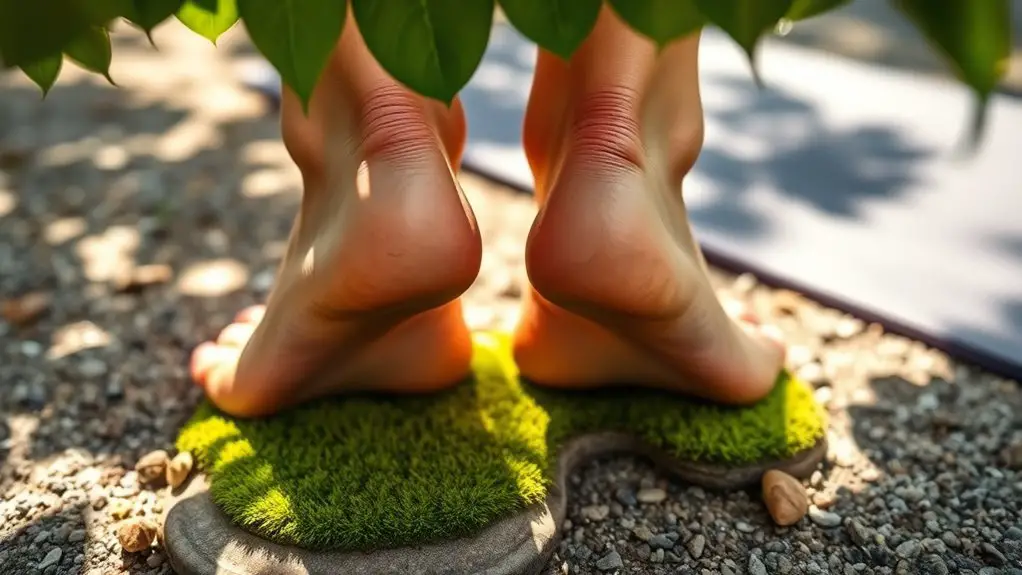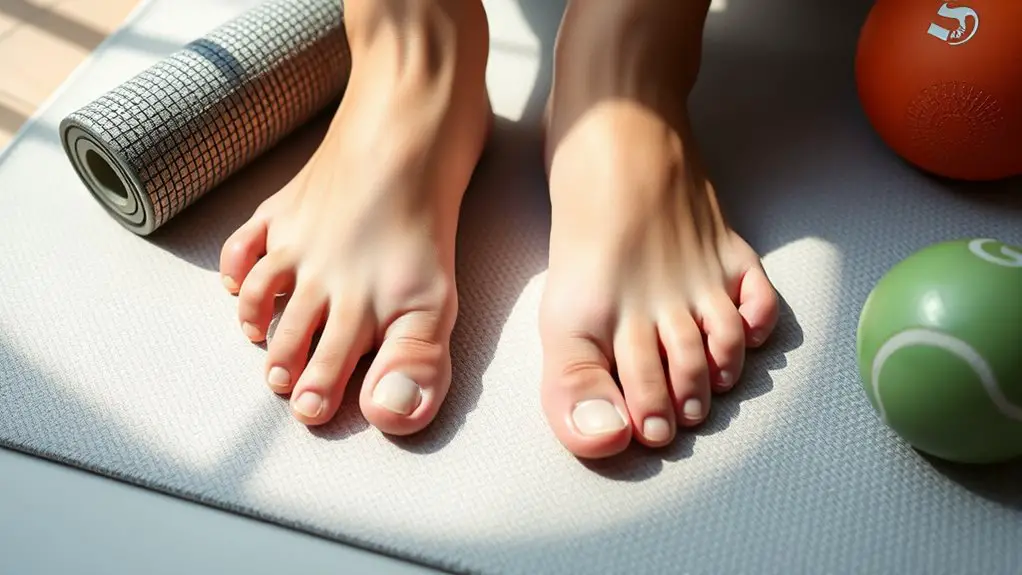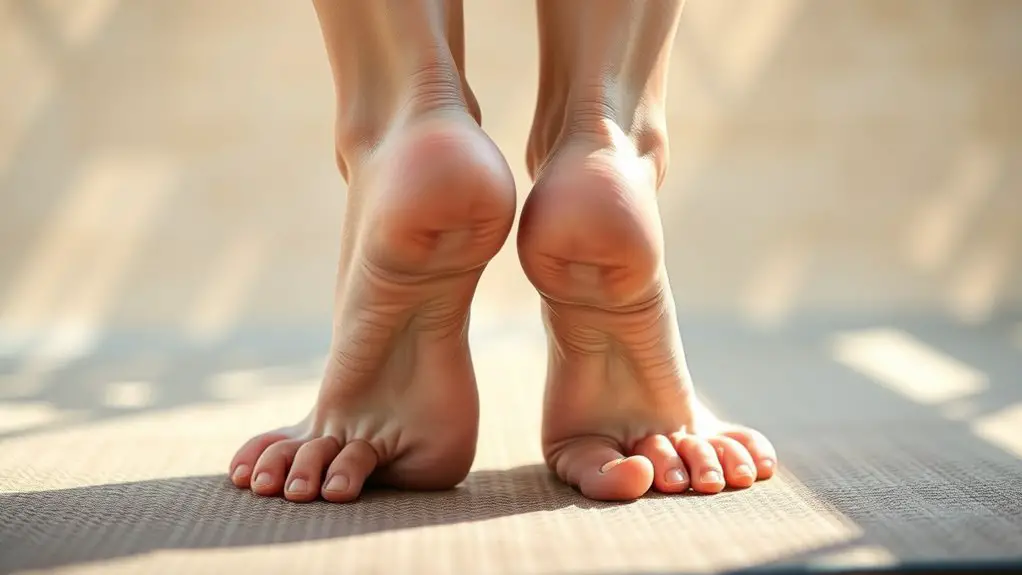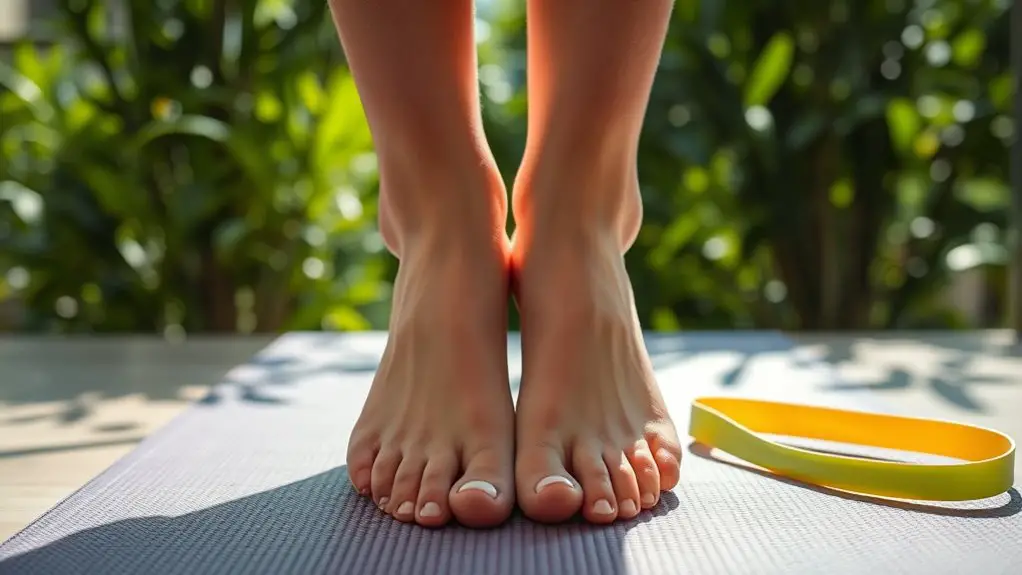To strengthen your heels and arches, focus on exercises like toe raises, which enhance heel stability, and arch lifts to support foot structure. Incorporate resistance band exercises for improved foot strength, such as band toe flexion and ankle dorsiflexion. Balance exercises, like single-leg stands and heel-to-toe walks, also promote stability. Prioritize these practices daily to prevent injury and improve overall foot health. Discover additional valuable exercises to enhance your routine and support foot function.
Understanding Foot Anatomy: Heels and Arches

Understanding the intricate structure of your feet is essential for appreciating how heels and arches function. Your foot structure comprises 26 bones, 33 joints, and numerous ligaments, tendons, and muscles, all working together to provide balance and support. The heel anatomy consists primarily of the calcaneus bone, which absorbs impact and provides stability during movement. It connects to the Achilles tendon, vital for walking and running.
The arches of your feet, including the medial, lateral, and transverse arches, distribute weight and adapt to various surfaces. These arches are supported by ligaments and tendons, including the plantar fascia, which runs along the bottom of your foot. Understanding how these components interact helps you recognize the importance of maintaining their strength and flexibility. By appreciating the complexities of heel anatomy and foot structure, you can better understand the need for targeted exercises to enhance their functionality.
Benefits of Strengthening Heels and Arches
Strengthening your heels and arches offers numerous benefits that extend beyond mere foot health. Improved strength in these areas not only enhances your overall foot stability but also supports proper alignment of your entire lower body. This improved alignment can reduce the risk of overuse injuries, such as plantar fasciitis and Achilles tendinopathy, which often stem from weak or imbalanced foot muscles.
Additionally, strong heels and arches contribute to better shock absorption during activities like walking and running, enhancing your performance and comfort. You’ll likely notice a decrease in fatigue, as your body can efficiently distribute weight and absorb impact. Moreover, investing in foot strength can lead to improved balance and coordination, essential for daily activities and athletic pursuits. By prioritizing the strength of your heels and arches, you’re not just promoting foot health but also laying the groundwork for a more active and injury-free lifestyle.
Basic Foot Stretching Exercises

Incorporating basic foot stretching exercises into your routine can greatly enhance the strength and flexibility of your heels and arches. These exercises focus on improving foot mobility and can help prevent injuries caused by tight muscles and ligaments. One effective stretching technique involves standing and placing your hands against a wall while keeping one foot back and straight, pressing your heel into the ground. This helps stretch the calf muscles, which directly impacts your arches.
Another beneficial stretch is the seated toe stretch. Sit on a chair, extend one leg, and grab your toes, gently pulling them toward you. This elongates the muscles in your foot and helps maintain flexibility. Remember to hold each stretch for at least 15-30 seconds, repeating multiple times. By consistently practicing these techniques, you’ll considerably improve the overall function and resilience of your feet, supporting better balance and movement.
Toe Raises for Heel Strength
Toe raises are an effective exercise for enhancing heel strength, which is essential for overall foot stability. By properly executing this movement, you can target the muscles in your calves and feet, promoting better arch support and reducing the risk of injury. Understanding the benefits and mastering the technique will help you incorporate toe raises into your routine effectively.
Benefits of Toe Raises
Although often overlooked, toe raises play an essential role in enhancing heel strength and overall foot stability. Engaging in toe raise variations helps strengthen the muscles in the feet, leading to multiple toe raise benefits. By regularly incorporating this exercise into your routine, you can experience improvements that include:
- Enhanced balance and coordination
- Reduced risk of injuries, such as plantar fasciitis
- Increased strength in the intrinsic foot muscles
- Improved posture and gait mechanics
These benefits contribute to a more robust foundation for your body, positively affecting how you perform daily activities. By prioritizing toe raises, you’re not just focusing on your heels but also fostering a healthier, more resilient foot structure.
Proper Toe Raise Technique
When you want to maximize the effectiveness of toe raises for heel strength, proper technique is essential. Start by standing with your feet shoulder-width apart, ensuring correct toe alignment. Engage your calf muscles as you slowly raise your heels off the ground, keeping your body straight. Hold the position briefly before lowering your heels back down. Focus on muscle engagement throughout the movement, as this will enhance strength in your heels and arches.
| Step | Action | Key Focus |
|---|---|---|
| 1. Position | Stand tall, feet shoulder-width | Toe alignment |
| 2. Raise | Lift heels while engaging calves | Muscle engagement |
| 3. Lower | Return heels to the ground | Maintain control |
Arch Lifts to Support Foot Structure

To effectively support the foot’s structure, incorporating arch lifts into your exercise routine can yield considerable benefits. This simple yet effective exercise enhances arch stability, improving overall foot posture and reducing the risk of injury. By regularly practicing arch lifts, you’ll strengthen the muscles that support your arches, promoting better alignment and function.
Incorporating arch lifts into your routine enhances foot stability, posture, and overall function, reducing injury risk and promoting alignment.
Here are some key benefits of arch lifts:
- Improved arch stability: Strengthens the muscles that maintain your foot’s natural curve.
- Enhanced balance: A stable arch contributes to better overall balance during activities.
- Reduced pain: Alleviates discomfort associated with flat feet or high arches.
- Increased flexibility: Encourages a greater range of motion in your foot joints.
Incorporating arch lifts into your routine can considerably enhance your foot health and improve your athletic performance. Make sure to practice them consistently for the best results.
Resistance Band Exercises for Foot Strength
Resistance band exercises are effective for enhancing foot strength, particularly through band toe flexion and ankle dorsiflexion resistance. By incorporating these movements into your routine, you can target the muscles in your feet and ankles, promoting stability and support for your arches and heels. These exercises not only improve strength but also contribute to overall foot health and functionality.
Band Toe Flexion
Enhancing foot strength is essential for maintaining healthy arches and heels, and band toe flexion exercises effectively target these areas. By incorporating band resistance, you can improve toe mobility and overall foot function. Here’s how to perform band toe flexion:
- Sit comfortably with your foot flat on the ground.
- Wrap a resistance band around your toes, anchoring the other end to a stable object.
- Gently flex your toes upward against the band’s resistance.
- Hold for a few seconds before slowly returning to the starting position.
Aim for 10-15 repetitions per foot. This exercise not only strengthens the muscles supporting your arches but also enhances your toe mobility, promoting better balance and stability in daily activities.
Ankle Dorsiflexion Resistance
Building on the benefits of band toe flexion, ankle dorsiflexion resistance exercises play a significant role in strengthening the muscles around the ankles and improving overall foot function. By incorporating resistance training into your routine, you can enhance ankle mobility, allowing for better control during various activities. To perform this exercise, secure a resistance band to a stable object and loop it around the top of your foot. While seated, pull your toes toward you against the band’s resistance, focusing on the movement at the ankle. Aim for 2-3 sets of 10-15 repetitions. This targeted approach not only improves strength but also supports the arches, contributing to better stability and reduced injury risk.
Balance Exercises to Enhance Stability
While you may focus on strengthening your heels and arches, incorporating balance exercises is equally essential for enhancing stability. These exercises help you develop coordination and improve your overall balance, addressing stability challenges you might face in daily activities. Here are some effective balance techniques to take into account:
- Single-Leg Stand: Stand on one leg for 30 seconds, gradually increasing the time as your balance improves.
- Heel-to-Toe Walk: Walk in a straight line, placing the heel of one foot directly in front of the toes of the other foot.
- Balance Board: Use a balance board to challenge your stability while engaging various muscle groups.
- Tightrope Walk: Imagine walking on a tightrope, placing one foot directly in front of the other while maintaining your balance.
These exercises not only enhance stability but also contribute to better foot health and overall strength.
Incorporating Foot Exercises Into Your Daily Routine
Incorporating foot exercises into your daily routine can considerably improve your heel and arch strength, ultimately promoting better foot health. To make this a habit, set daily reminders that prompt you to engage in simple activities like toe raises, ankle circles, or arch stretches. You can perform these exercises while you brush your teeth, watch TV, or even sit at your desk.
Consistency is key; aim for at least 10-15 minutes each day. Focus on controlled movements to maximize effectiveness and reduce the risk of injury. Integrating foot care into your routine not only strengthens muscles but also enhances flexibility and balance.
Consider tracking your progress in a journal or app, which can encourage you to stay committed. Remember, small, sustained efforts lead to significant improvements in your foot health over time. Prioritizing these exercises will help you maintain strong heels and arches, ultimately enhancing your overall well-being.
When to Seek Professional Help for Foot Pain
Even with a consistent routine of foot exercises, you may still experience pain that requires professional evaluation. It’s vital to recognize when to consult a healthcare provider. Ignoring persistent discomfort can lead to more severe issues.
Even with regular foot exercises, persistent pain may need professional attention to avoid more serious problems.
Look for these signs of injury:
- Pain that lasts longer than a few days
- Swelling or bruising around the affected area
- Difficulty walking or standing
- Sharp pain that worsens with activity
If you notice any of these symptoms, don’t hesitate to seek help. A healthcare professional can provide a proper diagnosis and treatment plan tailored to your needs. Early intervention can prevent further complications and enhance your recovery. Remember, your feet are essential to your overall mobility and well-being. Prioritizing foot health guarantees you can continue your daily activities without discomfort.
Frequently Asked Questions
How Long Until I See Results From Foot Exercises?
Like planting seeds, seeing results from foot exercises depends on your exercise frequency and personal variation. Generally, you might notice improvements within a few weeks, but consistent practice is essential for ideal strength gains.
Can Foot Exercises Help With Plantar Fasciitis?
Yes, foot exercises can provide plantar fasciitis relief. Incorporating specific stretching techniques can help alleviate pain, improve flexibility, and strengthen supporting muscles, ultimately leading to enhanced foot function and reduced discomfort associated with this condition.
What Footwear Is Best for Performing Foot Exercises?
You might think any shoes will do, but minimalist shoes or supportive sandals are best for foot exercises. They promote natural movement, enhance stability, and allow better engagement of foot muscles, essential for effective strengthening.
Are There Age Restrictions for Foot Strengthening Exercises?
There aren’t strict age restrictions for foot strengthening exercises. However, age considerations are essential; youth benefits from early intervention, promoting proper foot development. Tailoring exercises to individual capabilities can enhance effectiveness and prevent injury at any age.
Can I Do These Exercises if I Have Diabetes?
Like a delicate dance, incorporating foot exercises can aid in diabetes management. However, it’s essential to consult your healthcare provider first, ensuring your foot care routine aligns with your health needs and doesn’t pose risks.



